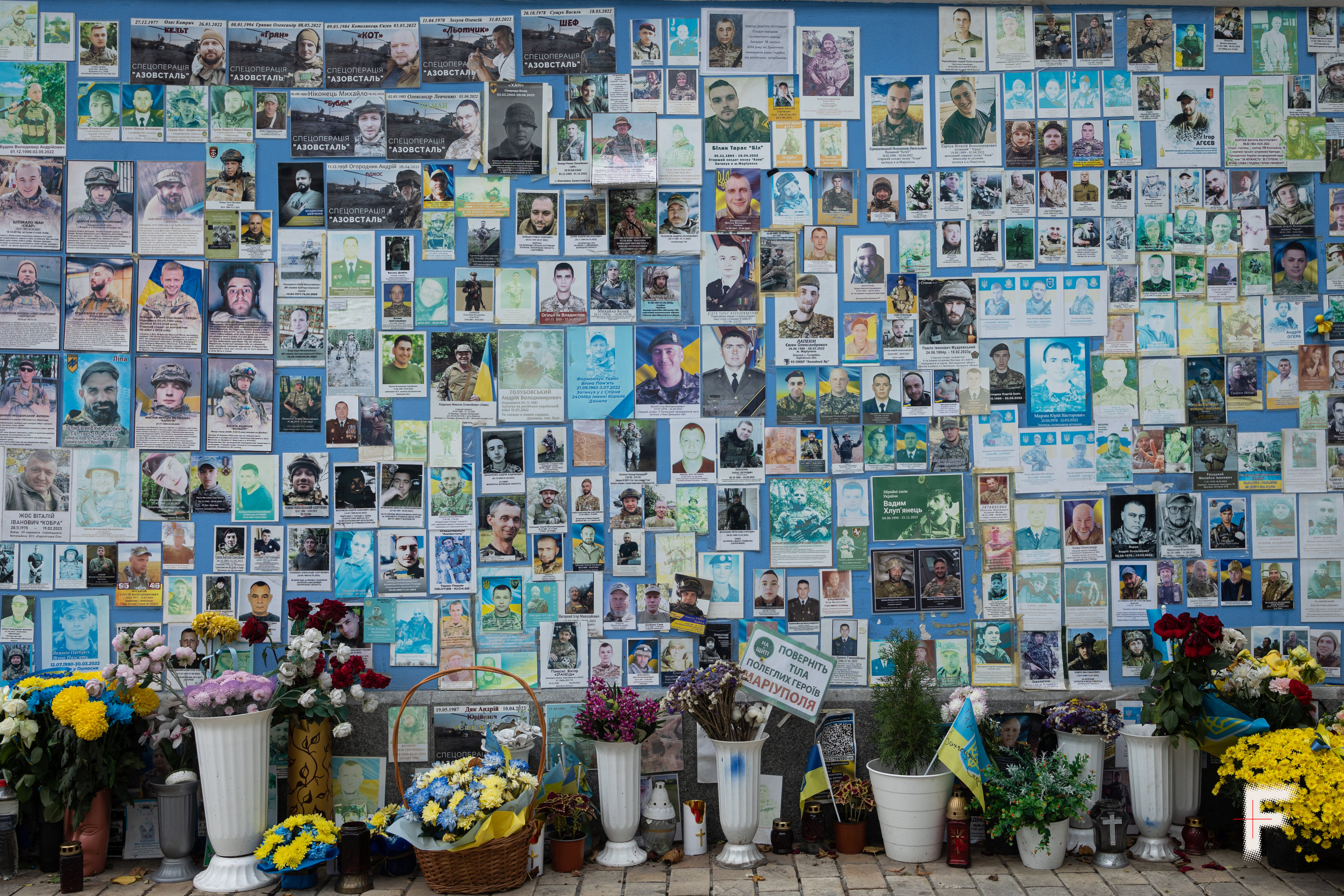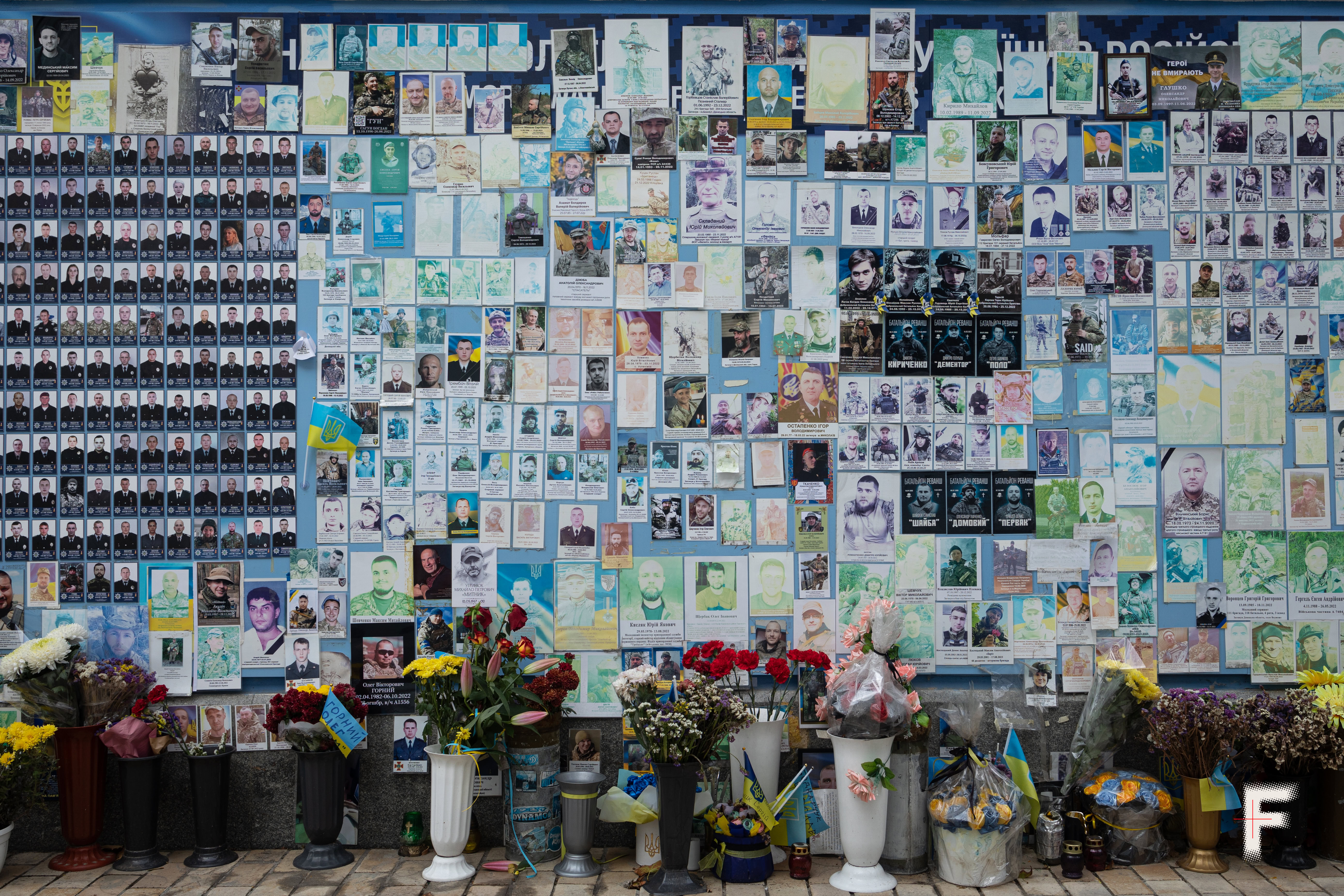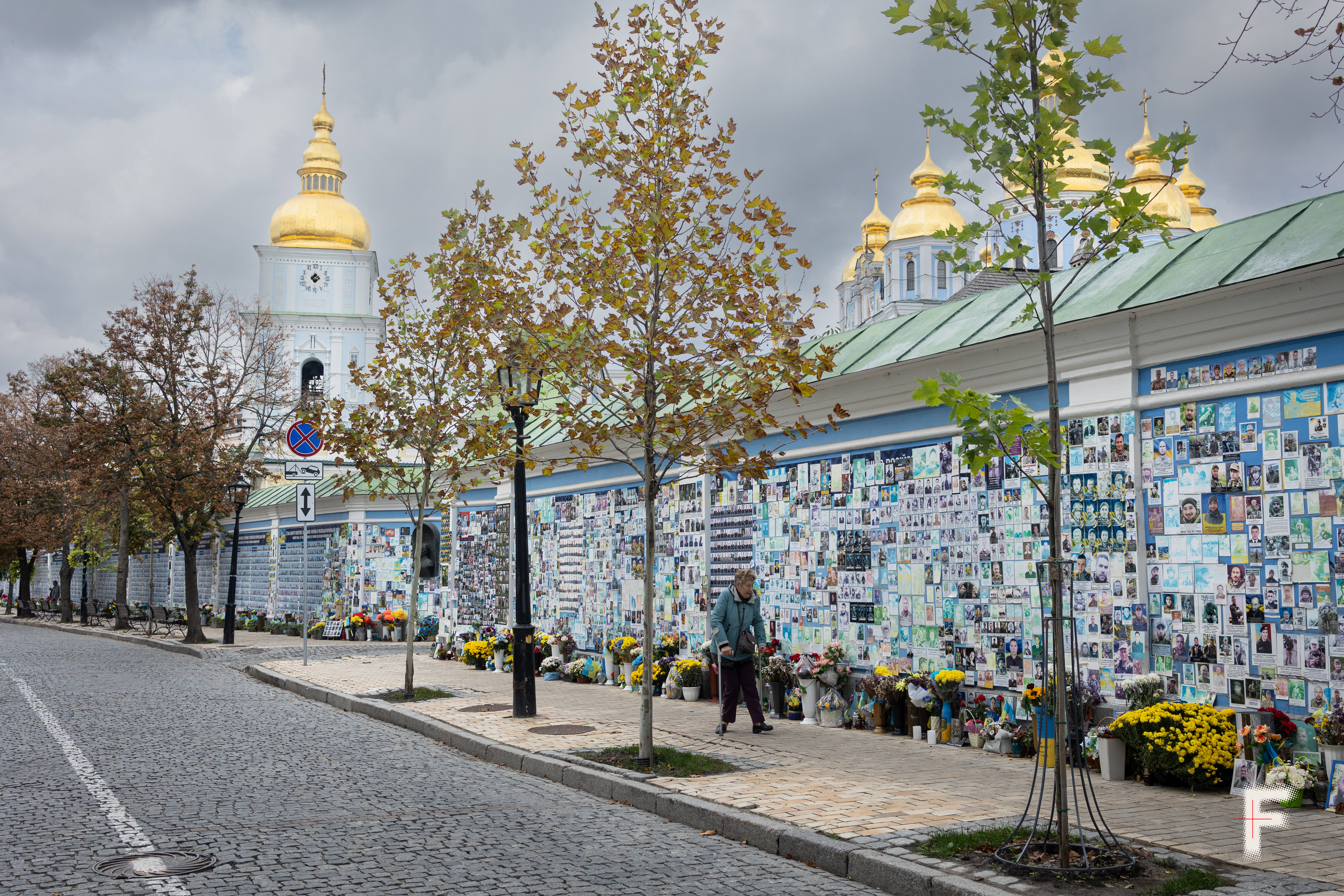

Kyiv Wall of Memory and spontaneous memorialization. How to honor the memory of all the fallen?
Kyiv's Memorial Wall on Mykhailivs'ka Square no longer has room for new photos of fallen soldiers. Before Russia's full-scale war, this memorial contained almost 5,000 portraits. Being doubled in size, it does not have the names of all the defenders who sacrificed their lives. Relatives and friends honor the fallen by adorning the Wall with flowers, lamps, candles, flags, and funeral wreaths. Faded photos, barely recognizable, remain as a poignant reminder of those who fell in battles. Who are the caretakers of this spontaneous memorial? Does it fit in the square’s ambiance? Is one wall capable of holding the memory of all those who died in the battles of the Russian-Ukrainian war?
I realize how much grief this caused, how many lives were crippled. I understand every mother, wife, and child.
The Nosachs is a couple from Kryvyi Rih, who came to Kyiv with the sole purpose of visiting the Wall of Memory. Dmytro, a seasoned 53-year-old soldier, saw this place for the first time. Taking a precious day from his hard-earned vacation to pay tribute to the fallen, he found a sea of portraits with his comrades. The man scanned hundreds of photos to find familiar faces. His wife, Victoria, fixed her gaze on the endless row of photographs, contemplating the price of peace and freedom that Ukraine is paying in this war.
“I realize how much grief this caused, how many lives were crippled. I understand every mother, wife, and child. Every story, every life is something… Something had to be different. In 2022, I had a grandson, so long-awaited, so longed-for. But when I pick him up, I don’t know what awaits him. We hope that Ukraine stands still and that all these sacrifices were not in vain,” the woman said.
“People are yearning to honor the fallen”
The 120-meter wall has no room for new pictures. It is now a patchwork of photographs, an overwhelming number of fallen heroes. Every inch of the wall, including the half-columns and even the ground beneath, is covered with portraits. Some photos hang a few centimeters off the ground, hidden behind flowerpots, while others are framed under the wall. Some are faded and barely recognizable, while others are layered over one another. Regardless, this wall cannot accommodate every fallen soldier.
We had a meet-up with Pavlo Netiosov, the museologist and the founder of this project. Being a soldier and contributor to Ukraine’s Military History Museum, Pavlo started this journey decades ago, searching for the missing soldiers of World War II. When the tragic events of 2014 unfolded, and Ukrainian soldiers were lost in the Ilovaisk encirclement, Netiosov understood the urgent need to memorialize these brave souls and ensure their sacrifices were not forgotten.
Within a month of the Ilovaisk tragedy, Pavlo Netiosov took leading the Evacuation 200 mission. Under the watchful eyes of separatist escorts, he ventured into the occupied territories of the Donetsk region to search for the fallen. The grim work yielded nearly 150 bodies. As his team identified most of the soldiers, Pavlo caught himself thinking: how to operate with the gathered information and their belongings?
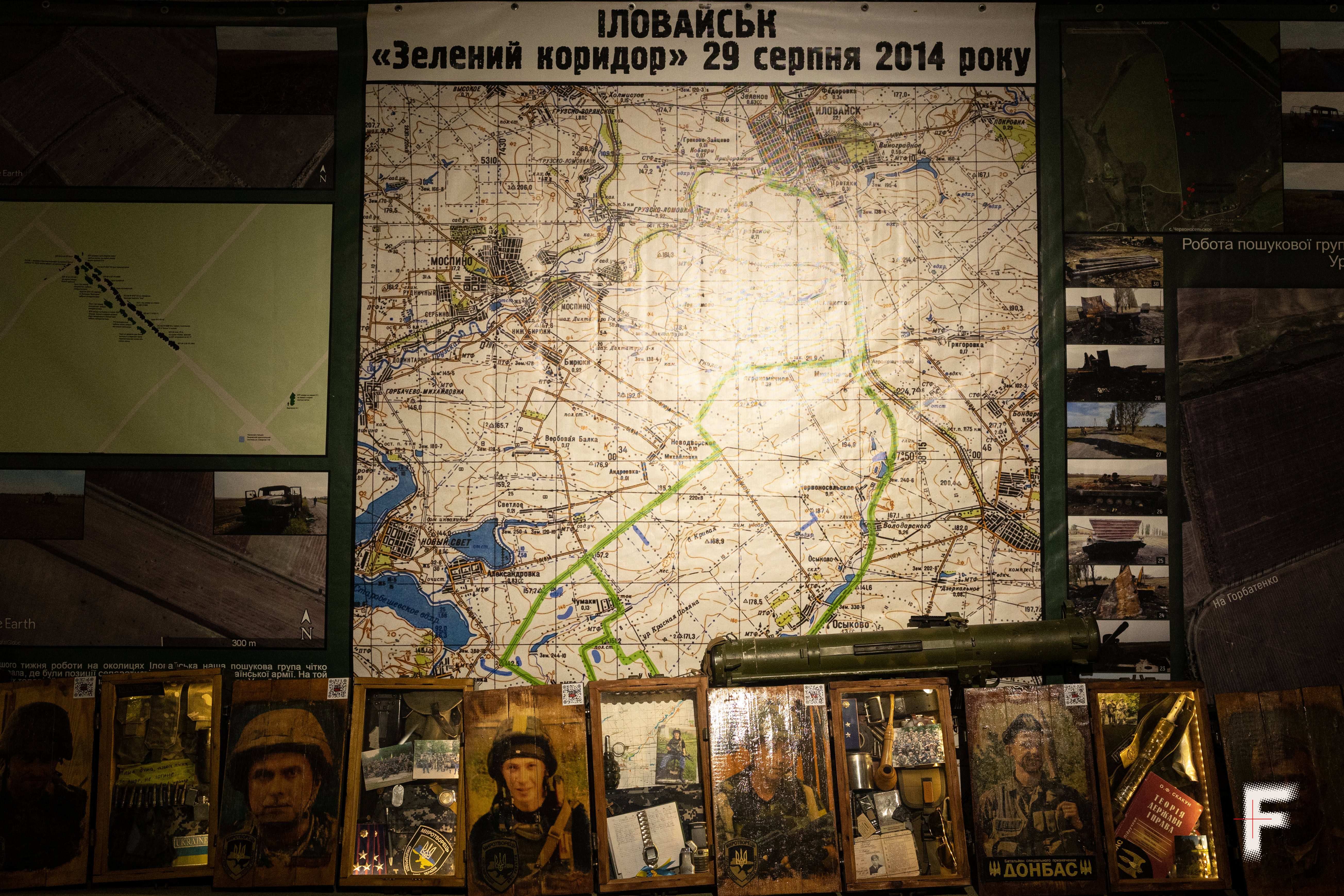

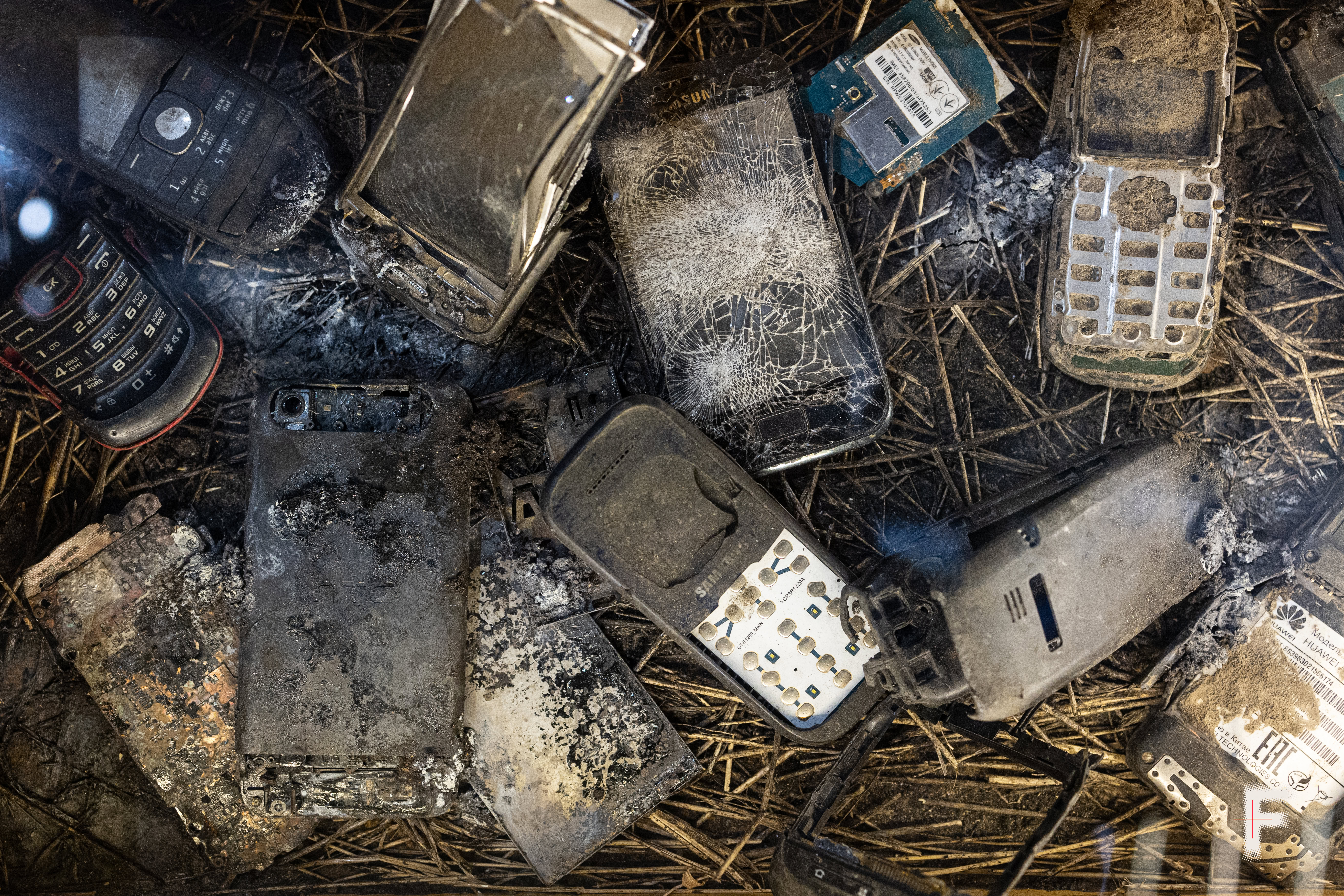

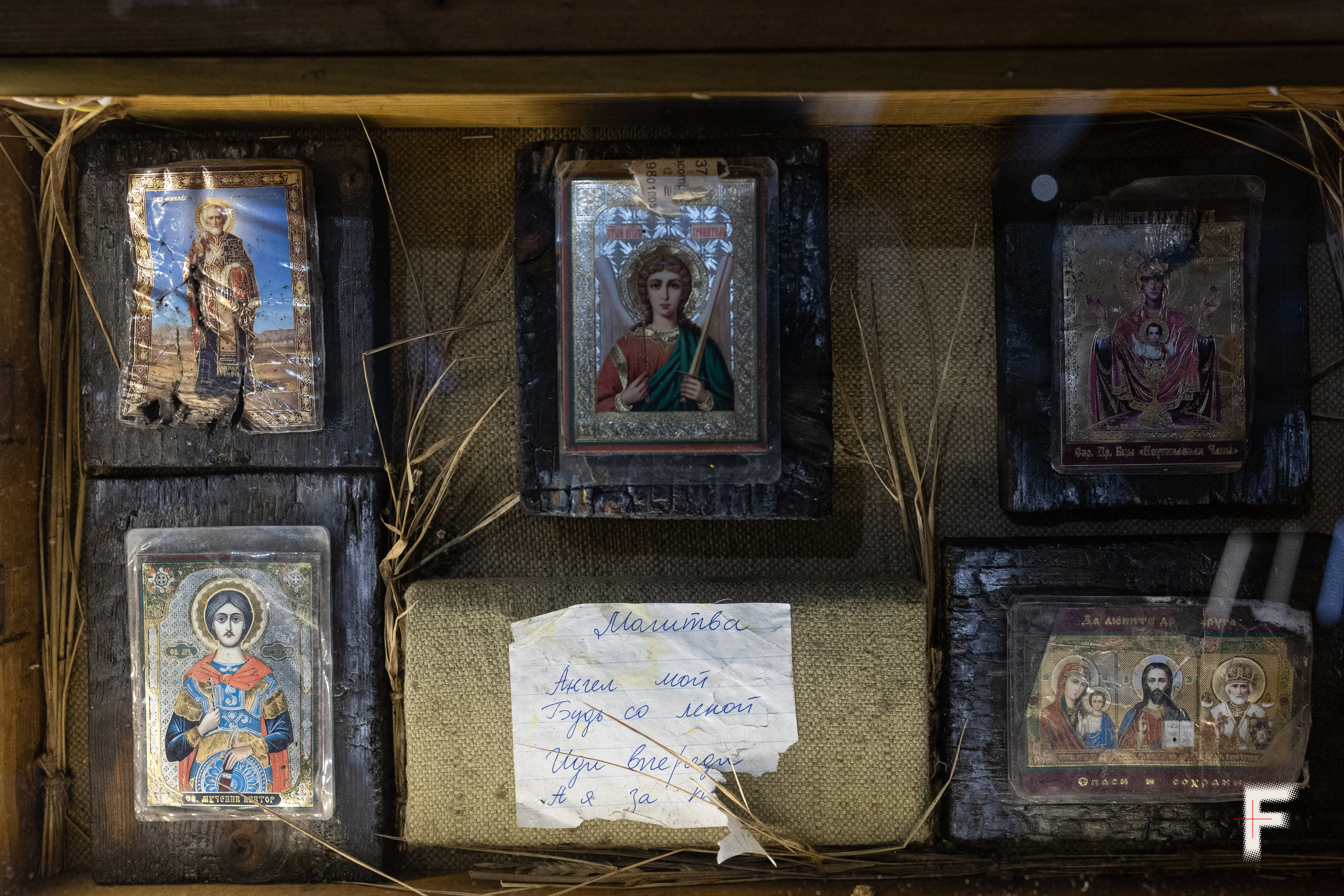

The volunteers gathered to hold an exhibition in memory of the fallen soldiers. The printed portraits and brief biographies of the lost soldiers were displayed on banners hung from the foundations of St. Andrew’s Church. To further honor their memory, a collection of personal belongings recovered from the battlefield was also exhibited. Families of the fallen came to the opening, while the church held a service in their memory.
Nika Sokol, Pavlo’s wife, has been co-developing the Wall of Memory for nine years. She still remembers her sheer surprise as she saw swarms of people wandering around the exhibition. She didn’t expect this project to be adored by many.
People started coming to lay flowers and bring candles or lamps. It was a very powerful impetus because it became clear that people yearn this.
Since then, the Wall of Memory initiative group embarked on a systematic effort to gather information from various sources. They cross-referenced official lists of casualties with accounts from grieving families and comrades. As the number of fallen heroes grew, it became evident that the walls of St. Andrew’s Church could no longer accommodate the ever-increasing number of portraits. The exhibition was relocated to the more spacious Mykhailivs’ka Square.
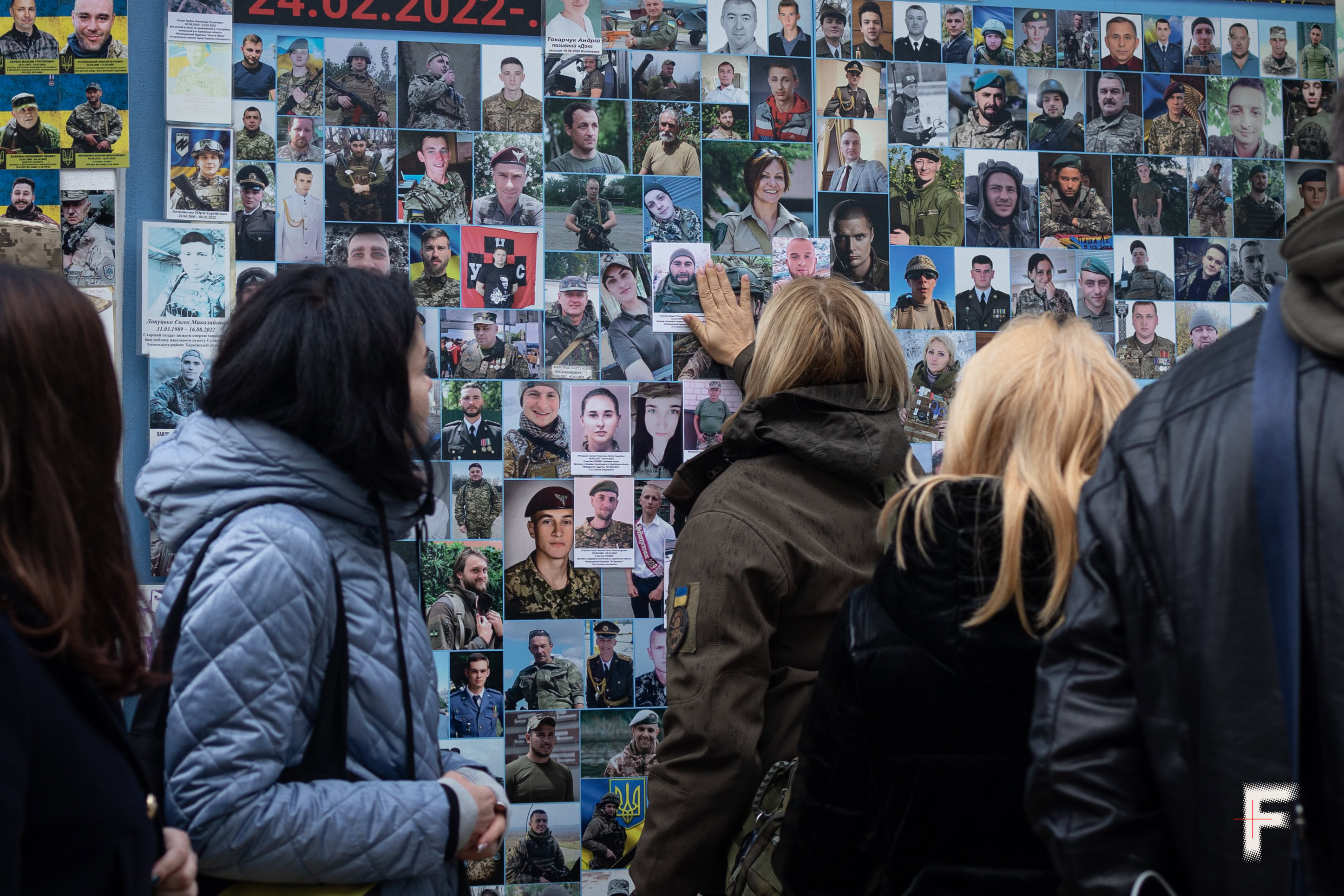

As the Wall of Memory grew, Ukrainians began to bring personal photographs of their loved ones to add to the memorial. Some of these portraits were, however, removed, as the group found spotted portraits of non-combat casualties. Netiosov says such situations have repeatedly led to conflicts. Families of fallen soldiers insisted on including individuals who had died under different circumstances (i.e., suicide). Conversely, these families, regardless of the cause, sought to honor their memory and felt deeply hurt when their loved ones’ photos were removed.
Since 2015, the memorial has been updated several times with new banners. The last one was hung in 2020 when volunteers recognized about 4,300 fallen Ukrainian soldiers.
“They deserve a little family visit”
The wall of memory gained a sacred meaning for the relatives of the fallen soldiers whose photos hang on Mykhailivska Square. Now, says Inna Katrych, sister of the deceased Vasyl Muzyka, soldier of the 58th Brigade, they can see their family only here, apart from the cemetery.
The only place where we can have a heart-to-heart talk with our family is either at their graves or near their photos.
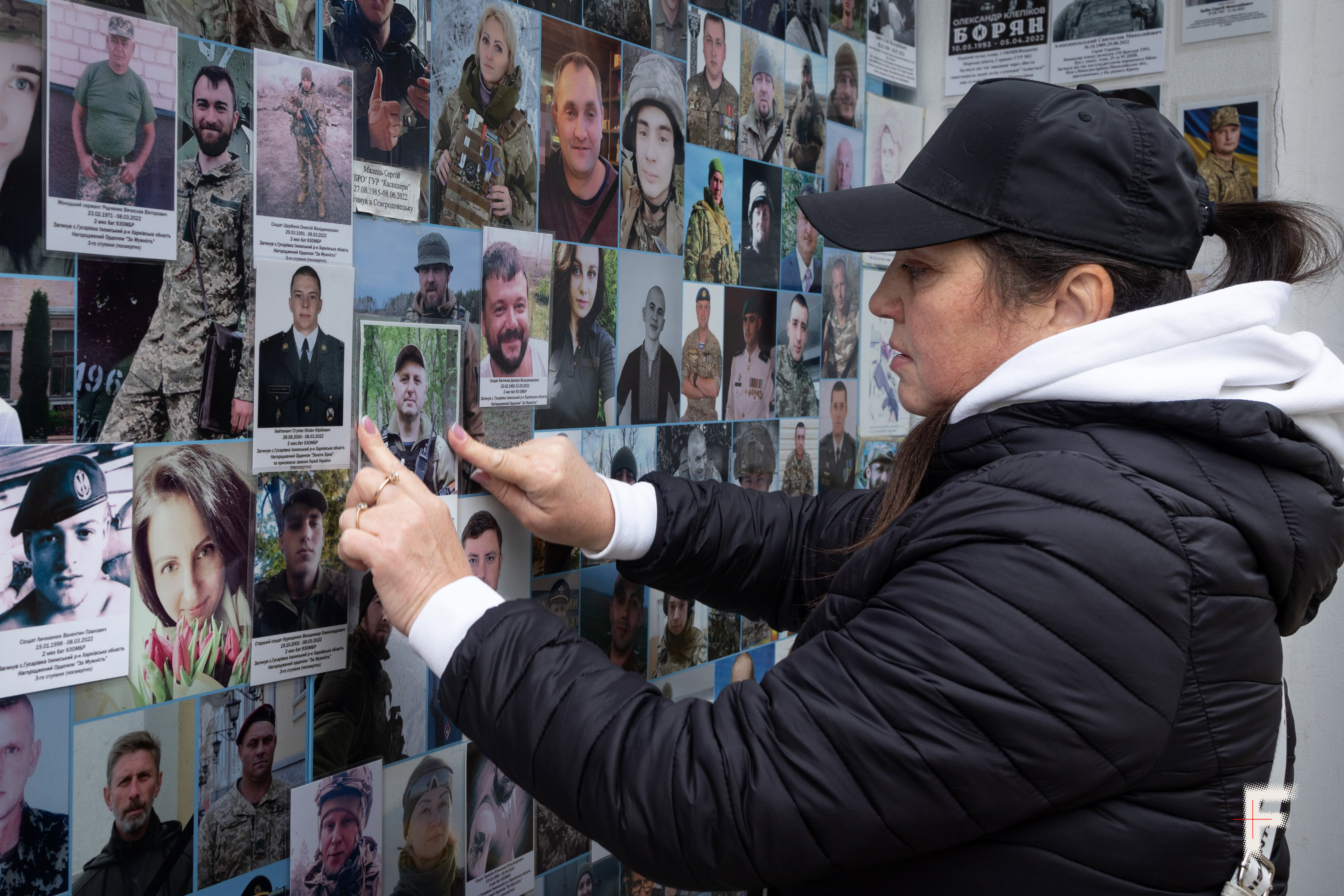

“The only place where we can have a heart-to-heart talk with our family is either at their graves or near their photos. That’s it. Unfortunately, we have nothing left of them,” Inna said, holding her tears.
Inna’s voice trembles as she recalls her brother Vasyl, a brave soldier who fought valiantly in the Serebryansky Forest in the Luhansk region. Despite successfully repelling enemy attacks, a fatal blow was struck by a Russian sniper. A single bullet, piercing his body armor and striking his heart, claimed his life.
47-year-old Vasyl was an infantry platoon commander and father of two. His eldest daughter started the university this year, while his son is graduating from high school.
Inna wipes her tears while cleaning her brother’s picture from old dust. She came to Kyiv to re-glue his photo. Since no one has taken care of the memorial since 2022, Inna has to come back regularly despite her mixture of anger and disappointment.
Her husband, Yurii, joined to help. The 60-year-old veteran quit the army ranks in 2024. While strolling near the wall, he keeps his eyes on his comrades from the 72nd Brigade. Yurii was just as surprised by the neatness of pictures that were placed exclusively before the all-out war.
“I understand that after 2022, the list will be devastating. Local authorities need to think of a solution because this wall doesn’t have more space. The fallen deserve a little family visit,” the man said.
«I would come here every single day»
Oleksandra Bilodid and her husband Serhi traveled over 300 kilometers to Kyiv from their hometown of Oleksandria in the Kirovohrad region. Here, they are replacing the photo of their deceased son, Anton.
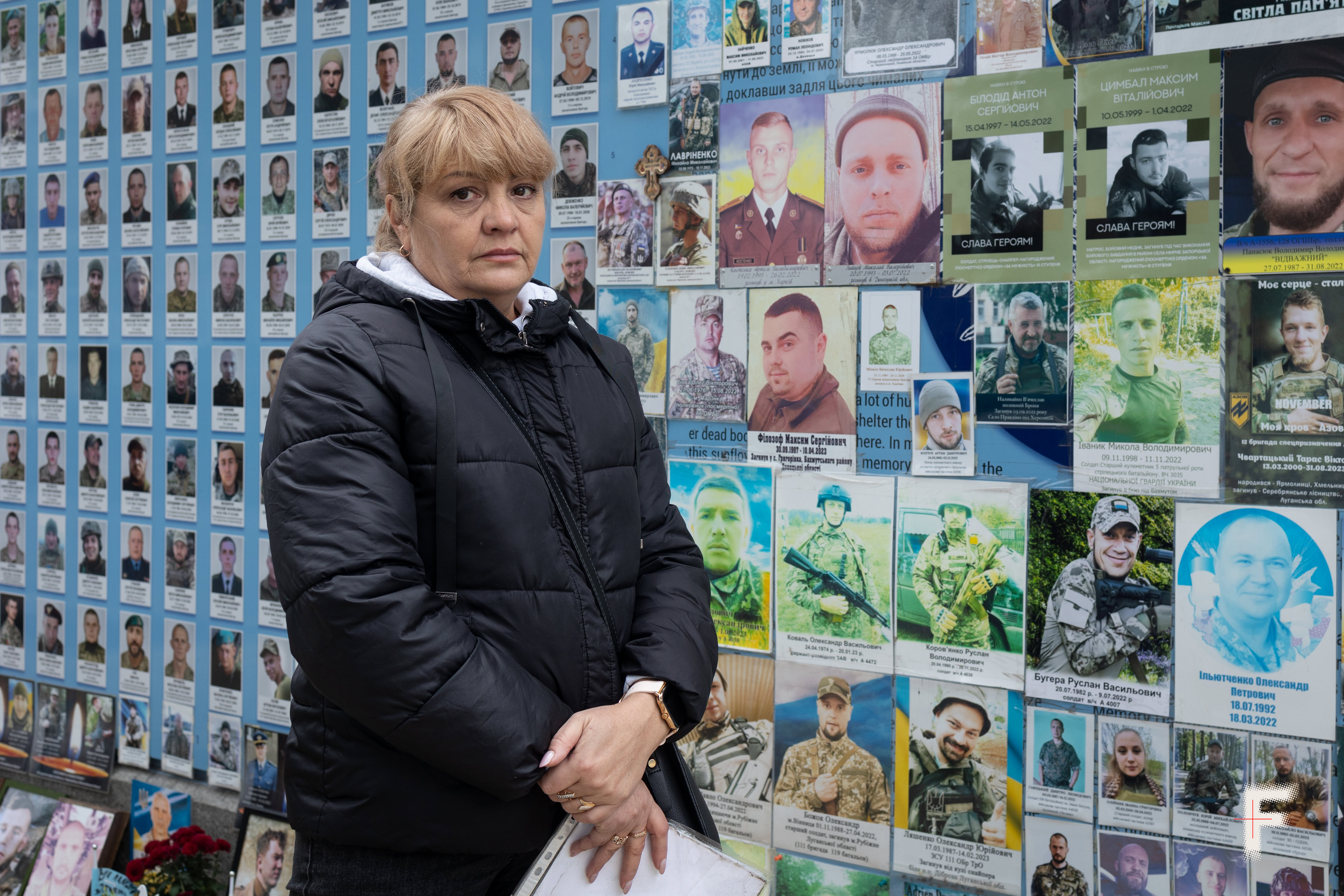

“It’s a long road for us to endure, but if I lived in Kyiv, I would come here every single day” the woman said.
Her son joined the Ukrainian army in the first days of the full-scale war. Anton was 24 when he signed up with the 57th Brigade as a sniper. His friend, 22-year-old combat medic Maksym Tsymbal, also answered the call to defend Ukraine in the 501st Marine Battalion. Maksym was killed on April 1, 2022, during an assault near the village of Myrne, Zaporizhzhia region. A few weeks later, Anton, having turned 25, also made the ultimate sacrifice. Now, these two friends, separated by war, are reunited on the Wall of Memory.
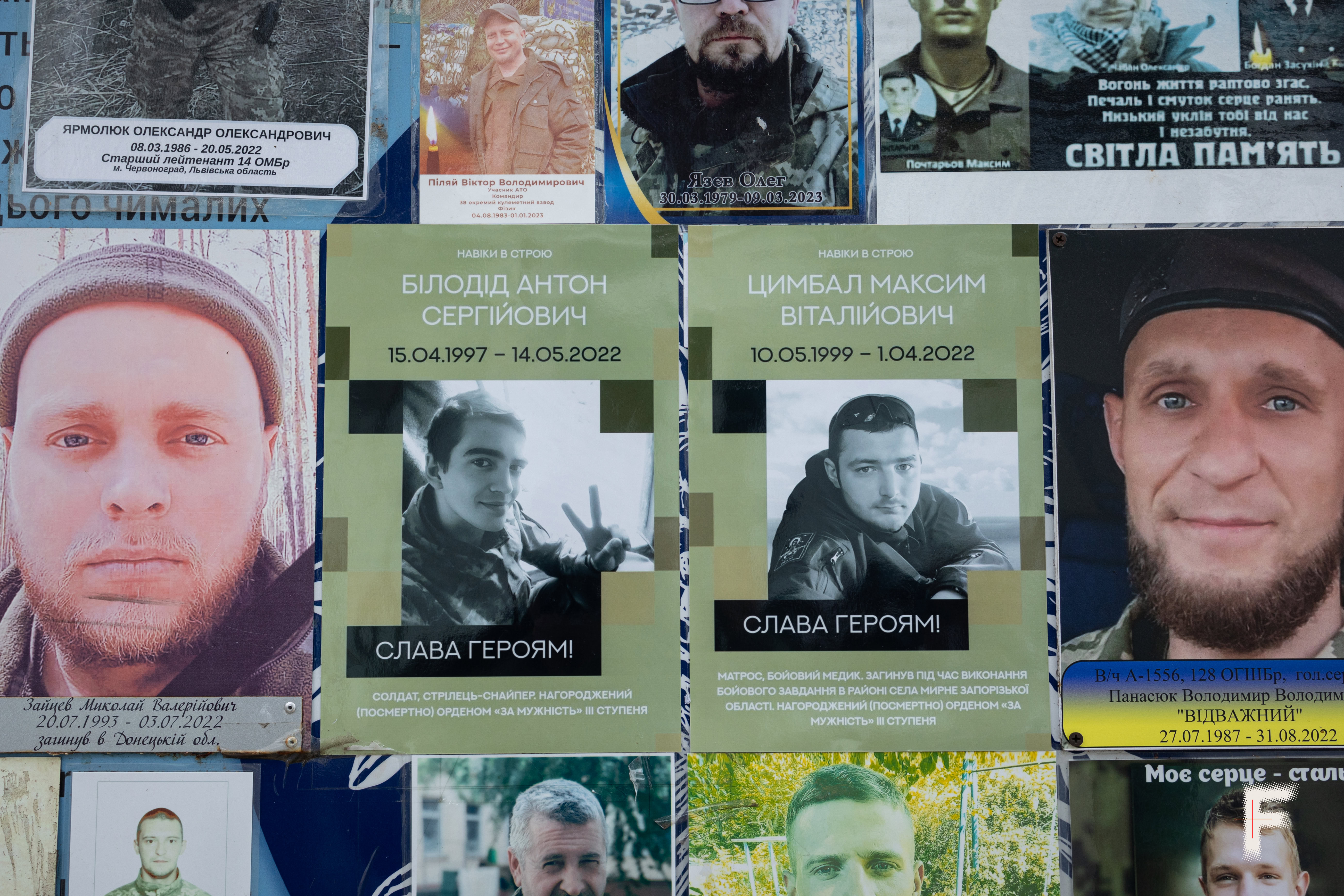

“You know, it’s a shame that they are becoming forgotten. Forgotten… I often notice that during the nationwide minute of silence, at 9 a.m., people just ignore it and move on. It’s a great shame,” the mother said.
Oleksandra carefully tears off the faded photo from the wall and glues a new one. Families shouldn’t be responsible for this, she assures.
“Should be good for a year. We’ll come back next time and change it again,” Oleksandra said.
The woman also honors her son’s memory in her hometown of Oleksandriia. On Memory Alley, there is a large banner with his portrait. Oleksandra appreciates the care and attention given to the memorial in her hometown. Unlike the bustling city of Kyiv, the portraits here are larger and better maintained. The municipal services diligently clean the area and tend to the flowers, creating a serene and respectful environment for remembrance.
Oleksandra dreams of erecting a monument at the site of her son’s death near the village of Borovske between Sievierodonetsk and Lysychansk. Both towns are now currently under Russian control.
Will the Wall be enough for every soldier?
So, why do all these families have to honor the memory on their own? Why does the commemoration remain spontaneous? While Kyiv’s utilities do make efforts to tidy the Wall of Memory, this is their only contribution to the memorial.
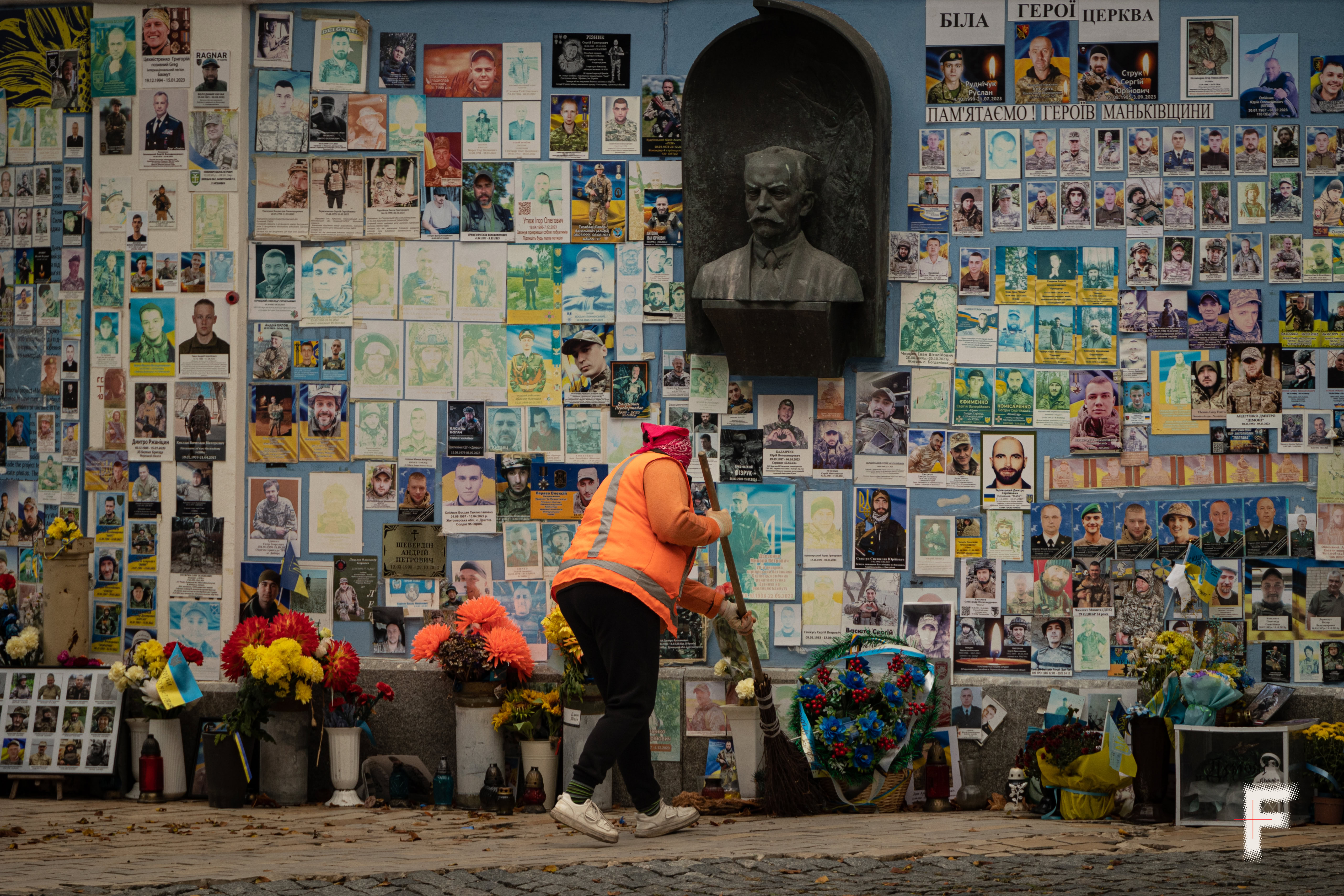

As Frontliner reported before, the nationwide culture of honoring Ukrainian soldiers is just being established. This issue requires careful consideration at the legislative level. By drawing inspiration from international practices and consulting with historians and experienced volunteers, policymakers can develop a memorial system that truly meets the needs of the families of the fallen.
We spoke to the families and asked them: if we are going to redo the Wall, how do they imagine it?
We wouldn’t want it to look like an endless list of names. They expressed a desire to maintain a personal connection, preferring photos. They envisioned a space where they could visit and interact with the portraits of their loved ones,” Sokol said.
Given the staggering number of casualties, the Wall faces capacity constraints. To preserve the integrity of this poignant memorial, the initiative group prioritizes maintaining its current form.
“The way the whole world sees it now is convincing. It’s a living entity. Any attempts to disturb it would be a scandal,” Pavlo Netiosov said.
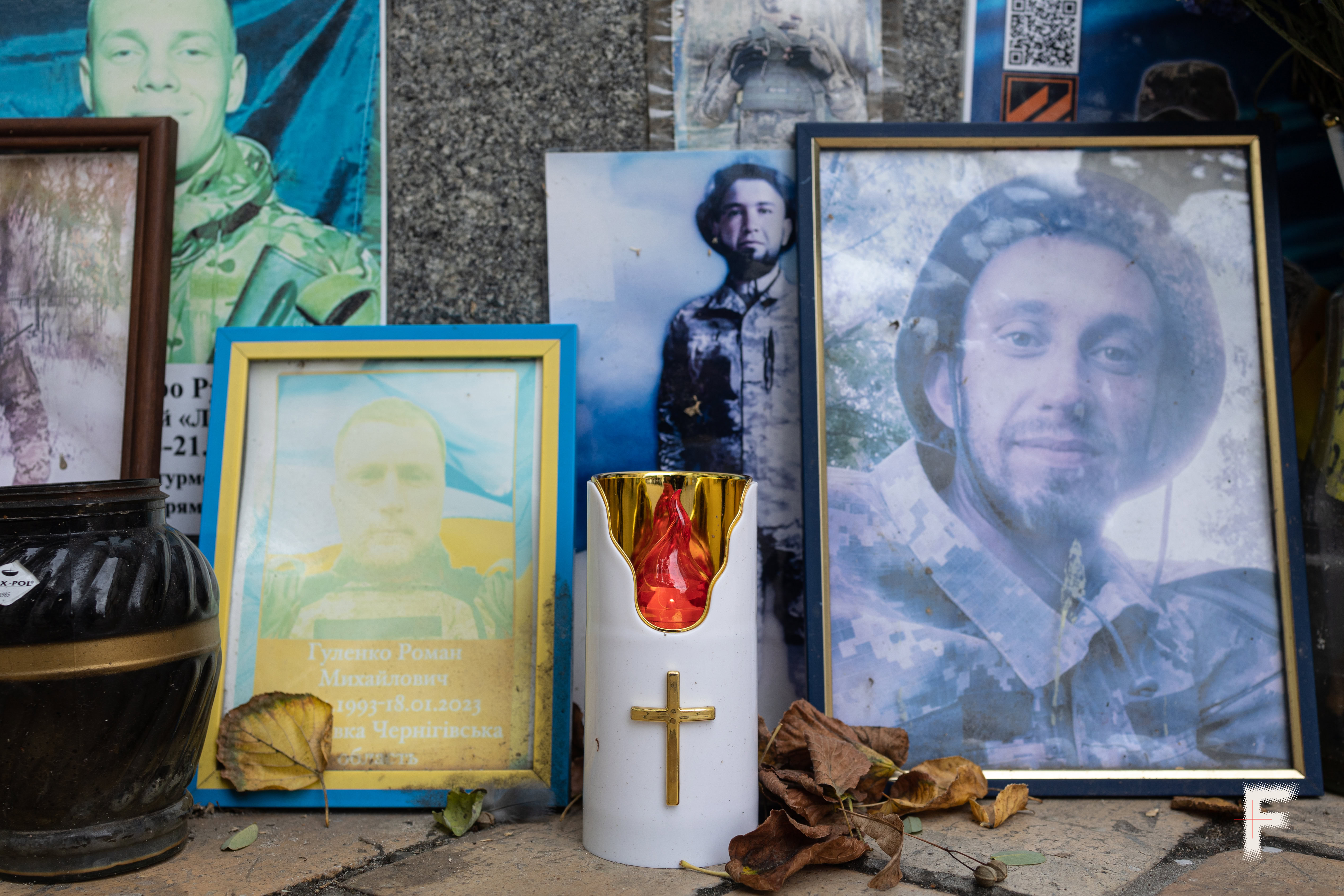

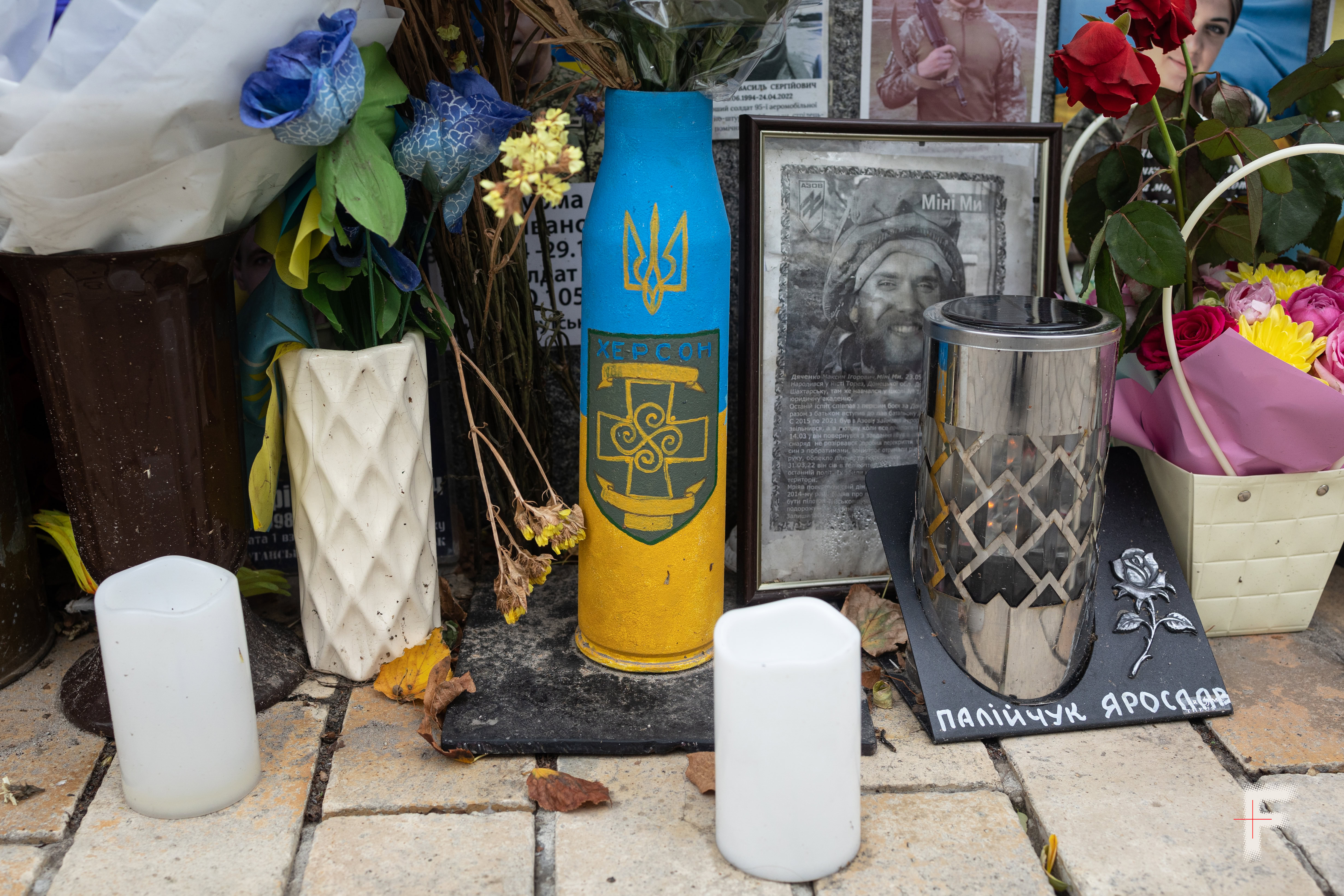

Pavlo lists various suggested solutions for the memorial’s makeover, including its relocation to the Kyiv-Pechersk Monastery, the Statue of Motherland, or installing monitors that would highlight the photos in a slide show. Netiosov disagrees with such proposals because Mykhailivs’ka Square is a well-known timeless space of faith, memory, and freedom.
“Try this trick in Arlington”
Right at the memorial, a sacred place for many, some explosive conflicts are regularly erupted. Pavlo says the Wall of Memory attracts local “lunatics ”, too. He has witnessed numerous incidents and often had to deal with the consequences.
“Police are never patrolling this place, but at least there are cameras. They were installed when our first structure was hammered-hit. Try this trick in Arlington. You’ll be tied up in a second. We have police only when a foreign delegation arrives,” Netiosov said.
Frontliner reporters also witnessed an unfortunate situation that almost escalated into a fight. While talking to Inna, the sister of the deceased Vasyl Muzyka, and her husband Yuriy, a passerby approached us.
My brother died. For us to live. Any other questions?
“How do I get to the metro station?” he asked the couple. Inna quickly wiped away her tears and explained the way.
“That way, right? Ah, thank you. What’s going on here?” the stranger, who seemed to have forgotten his way. I could smell a strong scent of alcohol. Standing two meters from the Wall of Memory, his question felt really unhinged.
Yurii calmly stated that he Inna are changing her brother’s picture. The drunk stranger seemed to be mocking the couple, asking a cruel question:
“Is everything alright here?”
Inna snaps. She shoves her brother’s picture at his face.
“See? My brother died. For us to live. Any other questions?”
Danylo and I repeatedly asked the stranger to leave us alone, but he persisted in questioning our presence. The man, however, repeats the same question over and over: “What are you doing here?“.
Yurii then snaps, too.
“Chopping wood”.
The scene erupts into chaos as the men engage in a heated argument. Inna attempts to intervene, her pleas for peace falling on deaf ears. Our photographer leaves the camera and rushes to aid. Together, they try to separate the combative men, but their efforts are futile. The men’s anger proves too strong, their grip too tight. The photographer and Inna are powerless to stop the inevitable clash.
Luckily, passers-by noticed and intervened, so the man was pushed back, and eventually headed to the station.
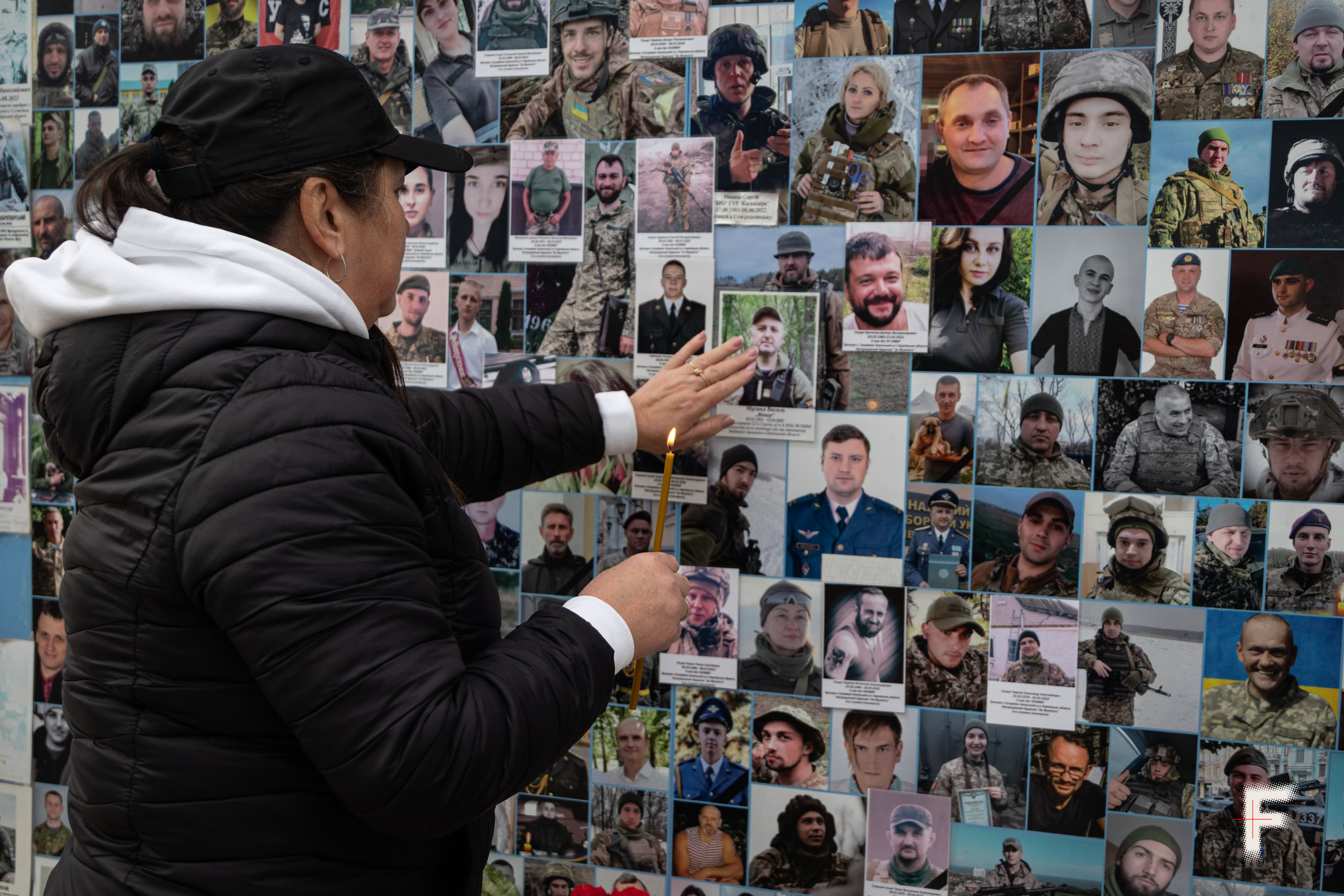

With trembling hands, Inna lights a candle and stands in front of the Wall to pray. She gently touches her brother’s photo, and then begins to look at the portraits of strangers to pray for them as well.
From local to nationwide memorialization
Having no established remembrance culture and commemoration of fallen soldiers, this gives a ground for answering some questions. What should memorials look like? Who should be in charge of them? When should they be created? During the war or after it is over?
Kateryna Semeniuk, curator of the Past / Future / Art memory culture platform, finds impossible to determine the right time to start working with traumatic experiences. Her initiative is engaged in the memorialisation of the war through art projects for Ukrainian and foreign audiences and advocating for changes in memory practices.
We must find our own language to remember this war.
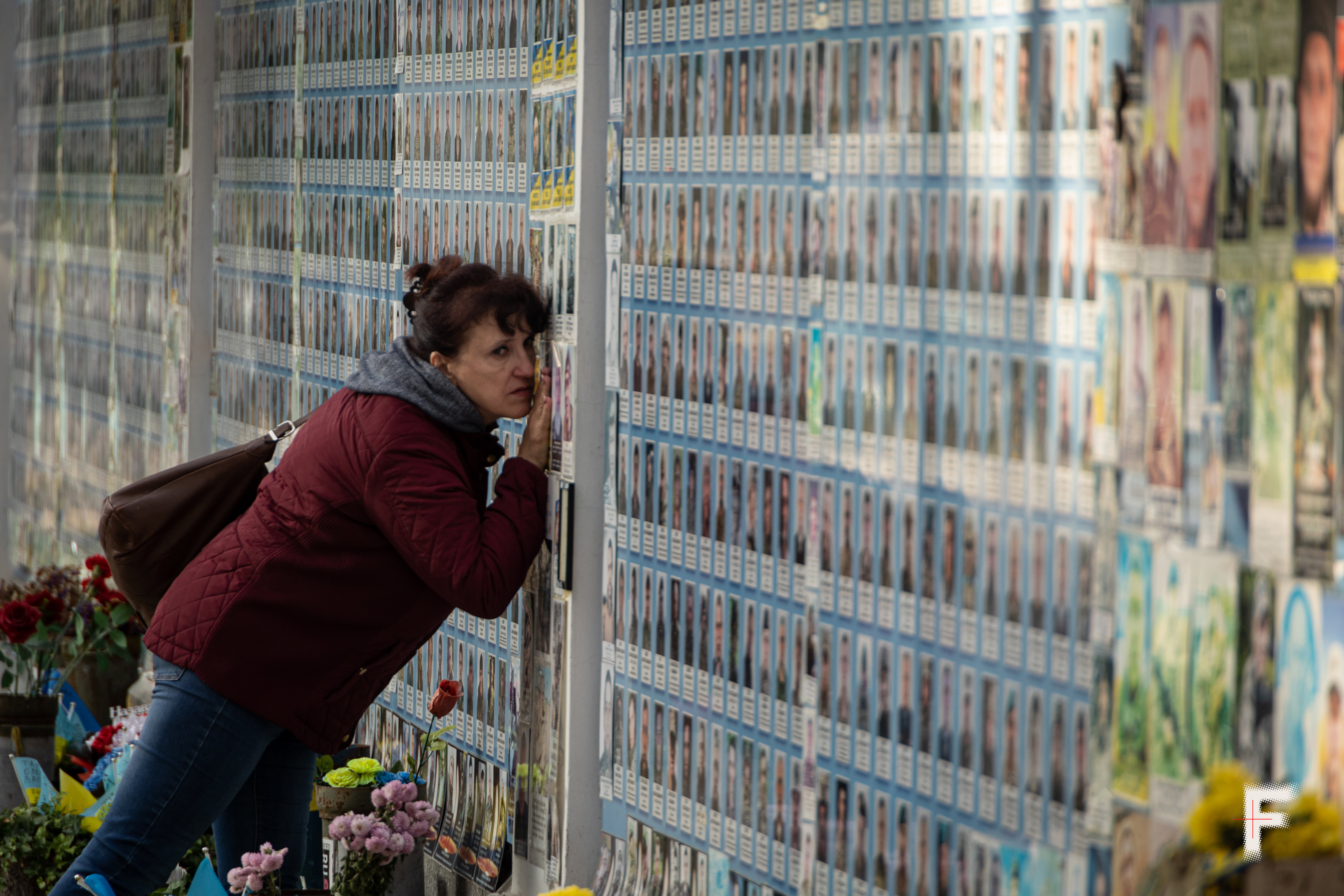

Kateryna believes that memorialization should be divided into local and nationwide. Spontaneous memorials, such as the Wall of Memory or the field of flags in Kyiv’s very center are known as local memorialization, prospered by people to help them grieve. Spontaneous memorialisation is likely to remain as such, Kateryna states.
“We must find our own language to remember this war. We are in the middle of a tragedy and we need to find a way to remember it,” she said in an interview with Nakypilo.
The nationwide memorialization is already being developed by experts: they are already imagining future memorials and their messages, and are engaged in a dialogue within society. However, the implementation of such plans will be possible only after the victory – when the names of all the defenders who sacrificed their lives are saved.
Experts are already envisioning future memorials and engaging in a societal dialogue about their message. However, the realization of these plans hinges on victory, when the names of the fallen are no longer .
Text: Viktoriia Kalimbet; Photo: Danylo Dubchak
